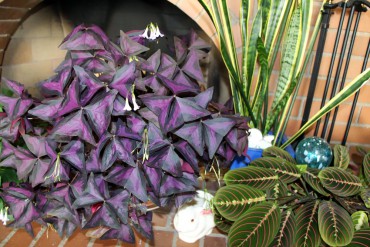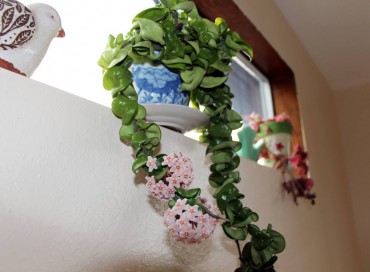During these sometimes gray winter months, we can still find plant pleasures indoors. Houseplants are the plants that keep on giving enjoyment all year long, whether it be with foliage or with cheerful and entrancing flowers.
Here are a few easy-care, no-fail plants from which to choose: Hoya, Sansevieria, Maranta, Holiday Cacti and Oxalis. Check with your favorite local nursery for availability. Some nurseries like Valley Nursery have an area dedicated to houseplants.
Hoya has leaves growing from long, trailing stems and flowers look like they’re made out of porcelain.
You’ll find several to choose from based on the leaf colors — dark green, green with spots, variegated cream and green and a ruffled leaf variety. Flowers resemble porcelain and come in shades of palest pink or white and resemble clusters of stars.
When the flowers fall off the flower stem, do not cut it back. Several times a year, year after year, the flowers will resprout from those appendages.

Hoyas like to be potbound and can tolerate good light, but not too much heat.
Maranta (aka Prayer Plant) has leaves that fold up at night and unfold in the daytime. The most common varieties are commonly called Herringbone Plant (M tricolor aka M. leuconeura erythrophylla) with prominent red veins, Rabbit’s Tracks (M. leuconeura kerchoveana) with brown blotches turning green with age and M. leuconeura massangeana with a blackish green leaf with silvery veins.
This plant will also sprawl like a vine but can be snipped back to stay in a more upright form. If you forget to water, the plant will communicate to you by wilting and folding its leaves. Never fear, just water it.
Sanseveiria, commonly called mother-in-law plant, is tolerant of sun and shade, even low-light conditions. It is a cactus-type plant and truly thrives on neglect.
Water about once a month and it will do just fine. It gets a bit wilty if neglected too long.
Some varieties of Sanseveiria are dark green, others are dark green with white, yellow or cream edges. You’ll find tall varieties and short clumping varieties.

University studies show that Sanseveiria is an air scrubber type plant purifying the air and studies recommend keeping a Sanseveiria in an office setting.
Holiday Cacti: First you’ll need to repeat this mantra, “Holiday cacti are easy to grow.” Remember this every time you read something that says how hard they are to grow and coax into bloom.
The newer varieties do not need to spend time neglected in a cool basement or garage and they are not dependent on special light conditions to flower.
They are epiphytic plants native to Brazil and growing in trees in the Organ Mountains (22 south latitude) with temperatures a constant 60-70 degrees F and rainfall at 17 inches per month during December through March.
We’ve known these plants as Schlumbergera. Some plant tags might label them Zygocactus, Epiphyllum, Cereus or Cactus. Some labels read Schlumbergera truncata (with yellow anthers on the flowers) or Schlumbergera bridgesii (flowers with purple anthers). Many of the epiphytes we purchase are crosses of these cultivars.
To further complicate matters, the Easter Cacti are really Rhipsalidopsis gaertneri.
Don’t panic about these seeming complexities. Provide the plants with lots of indirect light and water them at least once a month, sometimes weekly, but provide good drainage.
Oxalis is most commonly available at nurseries and home improvement centers around St. Patrick’s Day. You’ll find green leafed types and purple leafed types.
They like to be watered once a week or so and enjoy indirect, bright light. Clover-like leaves are held on tall stems. Flowers too are held on tall stems and are bell shaped in shades of pink and white.
Pull or snip off faded flowers and leaves and allow to become potbound. Oxalis grows from bulb-like corms stacked on top of each other, lengthening with age. If you’re lucky, you’ll eventually have lots of these bulblets to share with friends.
Oxalis sold as houseplants are not the same as the hardy Oxalis native plant found in nurseries and planted outdoors.
Even though botanical names are stated, usually houseplants are sold without any identifying information. Plant tags usually just say “houseplant.”
Three good books with information and lots of photos for identifying houseplants are: “Gardener’s Guide to Tropical Plants” by Nellie Neal, “The New House Plant Expert” by Dr. D.G. Hessayon and “The Complete Book of Cacti & Succulents” by Terry Hewitt.
The real trick to growing houseplants is to remember to discover how they grow in their normal environment in the wild. If you can replicate those conditions, you’ll have a happy houseplant.
Also remember that many houseplants, especially the ones featured in this blog, do well even when neglected. All of the plants mentioned benefit from regular watering. Use an all-purpose liquid fertilizer about once a month from April through August.
Learn about a few other plants in this episode of Gardening with Peg.




























Comments